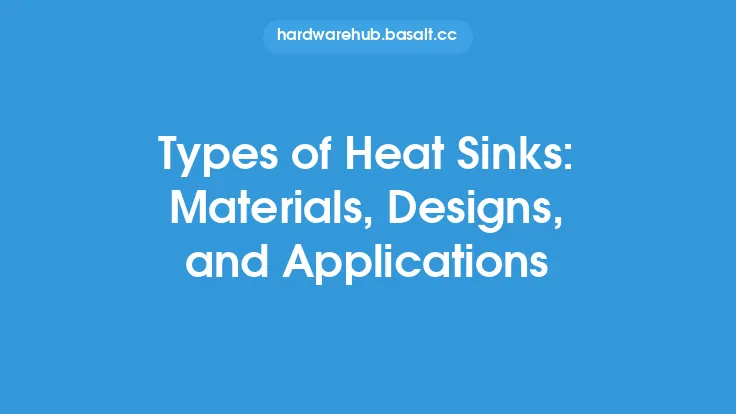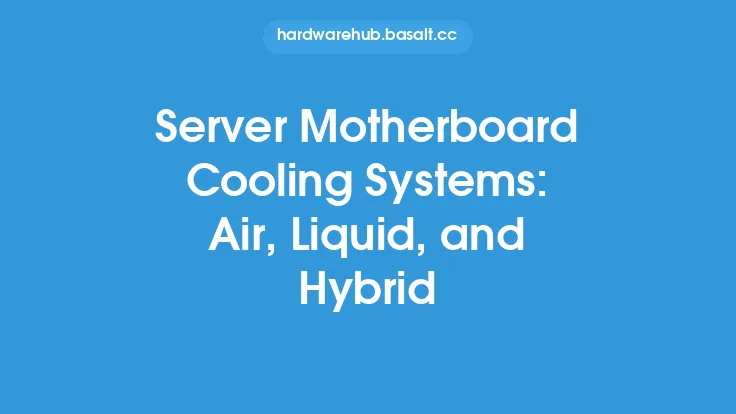Heat sinks are crucial components in cooling systems, and their performance is heavily dependent on the materials used in their construction. The choice of material can significantly impact the heat sink's ability to dissipate heat, and different materials offer varying levels of thermal conductivity, durability, and cost-effectiveness. In this article, we will delve into the properties and applications of copper, aluminum, and hybrid heat sink materials, exploring their advantages and disadvantages, and discussing the factors that influence their selection.
Introduction to Heat Sink Materials
Heat sink materials are designed to efficiently transfer heat from a source, such as a CPU or GPU, to a surrounding medium, like air or a liquid coolant. The ideal material should possess high thermal conductivity, which is the ability to conduct heat, as well as other desirable properties like low density, high strength, and resistance to corrosion. Copper, aluminum, and hybrid materials are the most commonly used options in heat sink construction, each with its unique characteristics and applications.
Copper Heat Sinks
Copper is an excellent heat sink material due to its high thermal conductivity, which is approximately 386 W/m-K. This means that copper can efficiently transfer heat, making it an ideal choice for high-performance applications. Copper heat sinks are often used in high-power devices, such as CPUs, GPUs, and high-end electronics, where heat dissipation is critical. However, copper is a dense material, which can make it more expensive and heavier than other options. Additionally, copper can be prone to oxidation, which can reduce its thermal conductivity over time. To mitigate this, copper heat sinks are often plated with a thin layer of nickel or silver to protect them from corrosion.
Aluminum Heat Sinks
Aluminum is another popular heat sink material, offering a good balance between thermal conductivity and cost. With a thermal conductivity of around 237 W/m-K, aluminum is not as efficient as copper but is still suitable for many applications. Aluminum heat sinks are commonly used in consumer electronics, such as laptops, smartphones, and desktop computers, where heat dissipation is important but not as critical as in high-performance devices. Aluminum is also lighter and less expensive than copper, making it a more attractive option for applications where weight and cost are concerns. However, aluminum can be prone to corrosion, especially when exposed to moisture, which can reduce its thermal conductivity and overall performance.
Hybrid Heat Sink Materials
Hybrid heat sink materials combine the benefits of different materials to create a high-performance heat sink. For example, a copper-aluminum hybrid heat sink can offer the high thermal conductivity of copper and the cost-effectiveness of aluminum. These hybrid materials can be constructed using various techniques, such as cladding, where a thin layer of copper is bonded to an aluminum base, or by using a composite material that combines the two metals. Hybrid heat sinks can offer improved thermal performance, reduced weight, and lower cost compared to traditional copper or aluminum heat sinks. However, the complexity of their construction can make them more expensive to manufacture, and their performance can be sensitive to the quality of the materials and the manufacturing process.
Factors Influencing Material Selection
The selection of a heat sink material depends on several factors, including the application, thermal requirements, and cost constraints. For high-performance applications, such as high-power CPUs or GPUs, copper is often the preferred choice due to its high thermal conductivity. However, for more cost-sensitive applications, such as consumer electronics, aluminum or hybrid materials may be more suitable. Other factors, such as weight, durability, and corrosion resistance, can also influence the material selection. For example, in applications where weight is a concern, aluminum or hybrid materials may be preferred due to their lower density. In harsh environments, where corrosion is a concern, materials with high corrosion resistance, such as copper or nickel-plated aluminum, may be necessary.
Thermal Interface Materials and Heat Sink Performance
The performance of a heat sink is not only dependent on the material used but also on the thermal interface material (TIM) used to bond the heat sink to the heat source. TIMs, such as thermal tapes, adhesives, or greases, can significantly impact the heat sink's ability to dissipate heat. A high-quality TIM can reduce the thermal interface resistance, allowing for more efficient heat transfer between the heat source and the heat sink. The choice of TIM depends on the application, with factors such as thermal conductivity, viscosity, and durability influencing the selection. In some cases, the TIM can be more critical than the heat sink material itself, and a poor-quality TIM can negate the benefits of a high-performance heat sink material.
Conclusion
In conclusion, the choice of heat sink material is critical in determining the performance of a cooling system. Copper, aluminum, and hybrid materials each offer unique advantages and disadvantages, and the selection of a material depends on the application, thermal requirements, and cost constraints. By understanding the properties and applications of these materials, designers and engineers can create high-performance cooling systems that meet the demands of modern electronics. Whether it's a high-power CPU or a consumer electronic device, the right heat sink material can make a significant difference in the overall performance and reliability of the system. As the demand for more powerful and efficient electronics continues to grow, the development of new heat sink materials and technologies will play a critical role in enabling the creation of smaller, faster, and more reliable devices.





